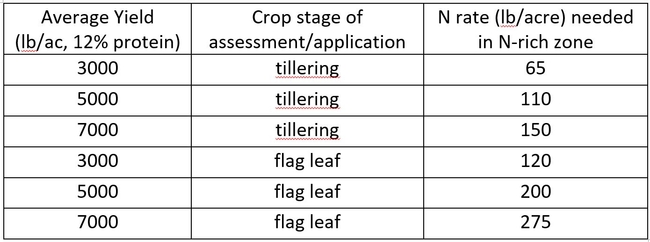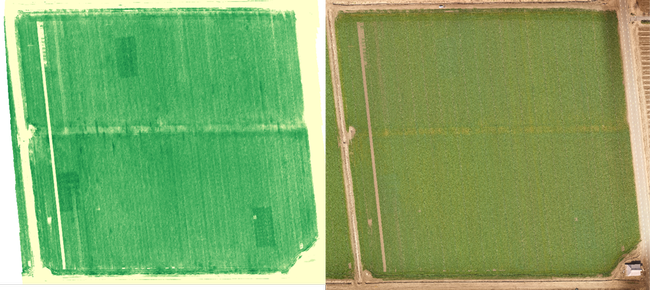This is our second in a series of blog posts on improving nitrogen (N) use efficiency in California small grains. This post focuses on the use of N-rich reference zones to assess in-season N status and make management decisions based on crop need. Our goal is to help growers and consultants learn how to use N-rich zones to improve small grain N fertilizer use efficiency and reduce negative environmental outcomes. To demonstrate what we know about this practice across the small grain growing regions of the state, our team has helped growers establish N-rich zones in their fields across a wide range of soil and climatic conditions. These demonstration sites are in the Sacramento Valley, Delta Region, San Joaquin Valley, and the Intermountain Region.
What are “N-rich reference zones” and why are they useful?
Reference zones are most useful to growers who apply most of their seasonal N budget during or after tillering. The reference zone is a relatively small area within the field where extra N fertilizer is added at the beginning of the season. This extra fertilizer ensures that the reference zone is not N limited between planting and the time when an in-season fertilizer decision is made. When a grower is determining whether and how much N fertilizer to add in-season, measurements from both the reference zone and the broader field are compared to understand whether the broader field is sufficient in available N. There are two important considerations when creating N-rich reference zones: fertilizer N rate and field variability.
Fertilizer N rate
The amount of N to apply in the N-rich zone will depend on several factors such as yield goal, protein goal, and when the expected in-season fertilizer application will take place. There should be sufficient N applied to the reference zone at planting to ensure that the plants in the zone are not limited by N at the stage of growth when the in-season fertilizer is applied. Table 1 (below) gives some examples of how much N fertilizer to apply to the N-rich zone for a range of yield potential.
Field variability
It is important to establish the N-rich zones in representative parts of the field. Areas of the field that are unique (i.e. low areas, high areas, gravel strips, etc.) should be avoided. It is also important that the zones capture field variability. If certain areas have distinct soil types or known patterns of yield or management differences, a grower should establish enough zones to account for these sources of spatial variability if they represent large areas in the field. Soil maps and historical aerial imagery can often help in identifying field patterns and good location(s) for reference zones. The N-rich zone should be marked so that in-season measurements can be determined separately from the rest of the field. Remember, the point of the N-rich zone is to provide a field and season-specific reference zone of adequate soil N relative to the larger field.
How and when to apply the N-rich zone fertilizer
A grower can establish N-rich zones during the pre-plant fertilizer application. For example, a grower may apply 50 pounds of N per acre across the field and then make another pass or two in the zone to apply an additional 50 to 100 pounds of N per acre (depending on what the grower calculates is necessary, as described above). This method might be most easily adopted by growers. We have observed, however, that if the fertilizer is shanked in too deep, the N may not be readily available to the crop early in the season because it is below the root zone. Therefore, N-rich zones established with this method may not provide a reliable early season point of comparison. Instead, we have found that broadcasting urea is the most effective way to establish N-rich zones. At our demonstration sites, we broadcasted urea after tillage or shortly after planting, but always ahead of a storm or irrigation event. At least 0.5 inches of water is needed to ensure N incorporation and availability in the upper part of the soil profile. At our demonstration sites, we made our N-rich zones 180 feet by 90 feet (0.37 acres), so that we can use satellite imagery for observations. While N-rich zones do not have to be that large, they should be big enough to represent field variability, such as 50 feet by 100 feet (0.12 acres). Orienting the zones perpendicular to the rows or tractor passes also helps to capture field variability. When the zones are too narrow and run in the same direction as the field work, it can be hard to differentiate between a field pattern associated with equipment passes and a N effect, particularly early in the season.
Monitoring the field during the growing season
Once the crop begins to grow, the field can be monitored periodically to assess whether the crop is likely to respond to a N fertilizer application. A combination of the soil nitrate (NO3-) quick test and canopy and leaf reflectance measurements taken from both the N-rich zones and the broader field can indicate when a topdress fertilizer application may be needed. Figure 1 depicts side-by-side images from a field in Solano County where N-rich reference zones were implemented this season. The image on the left represents the Normalized Difference Red Edge index (NDRE) values recorded from the field using a drone-mounted camera at tillering. The image on the right was taken at the same time but represents only colors that are visible to the naked eye. At this field, the NDRE measurement was able to identify a N sufficiency difference between the broader field and the three N-rich zones. In short, canopy reflectance measurements like NDRE are sensitive to crop N uptake. By implementing N-rich reference zones, monitoring them during the season, and comparing them to the broader field, a grower can see in real-time when the broader field is likely to respond to N fertilization. With this information, the grower can avoid fertilizer applications when crop response is uncertain and make applications when crop response is likely. The next blog post in this series will describe the use and interpretation of canopy and leaf reflectance devices in more detail.
Table 1. Approximate N fertilizer application rates suggested for use in N-rich reference zones based on a range of average yields and two stages of crop growth. Suggested rates ensure that crops within the reference zone are not N-limited when an in-season fertilizer application decision is being made at the crop stage indicated.
Figure 1. A field in Solano County where three N-rich reference strips are visible at tillering using a canopy reflectance measurement (left), but not visible to the naked eye (right).

